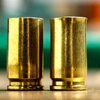Ok, so 9mm bullets have various diameters - .355 for full jacked, .356 for plated as they are just lead with an electro plating of copper which is more to prevent lead gasses in confined spaces, and pure lead which runs .357 up to .360. The "slight bulging" caused by .356 or larger bullet shouldn't be a problem IF your loaded cartridge resembles the SAAMI dimensional drawing attached last. AND passes plunk test.
Let me venture into bullet seating and taper crimp. As shown in one of the pics, 9mm brass is tapered in the case giving more thickness down to the case head. I often use 1.135 seating depth for plated bullets and can see the same expansion of the case as you identified - slightly. Mic the mouth rim where we should be seeing something around .378 to .381. Really, we should just take out the case flare we made at the expander. It''s only a small length at the mouth of the cartridge. I personally don't crimp so hard that I engrave a ring around the bullet. I just want ample neck tension to prevent set-back caused by recoil while rounds sit in the magazine. The crimp need not be excessive.
I was taught to mic rim thickness, multiply that by 2, mic the bullet, add 'em. Winchester tends to be .011, so twice that is .022. Plated tend somewhere around .356 so the total is .378 Flare coming out of the expander should be As slight as will work to start bullets at the seating die - +.003 to .005. The objective is to taper crimp the case back to something ar or a tad bigger than .378 - say .380/.381.
Without a case in hand or a pic w/ dims, it's had to say, but I don't think this is causing an ejection issue, but let me ask what dies are you using? And, what dim are you getting down at the case head? It should be very close to the SAAMI spec.
I







